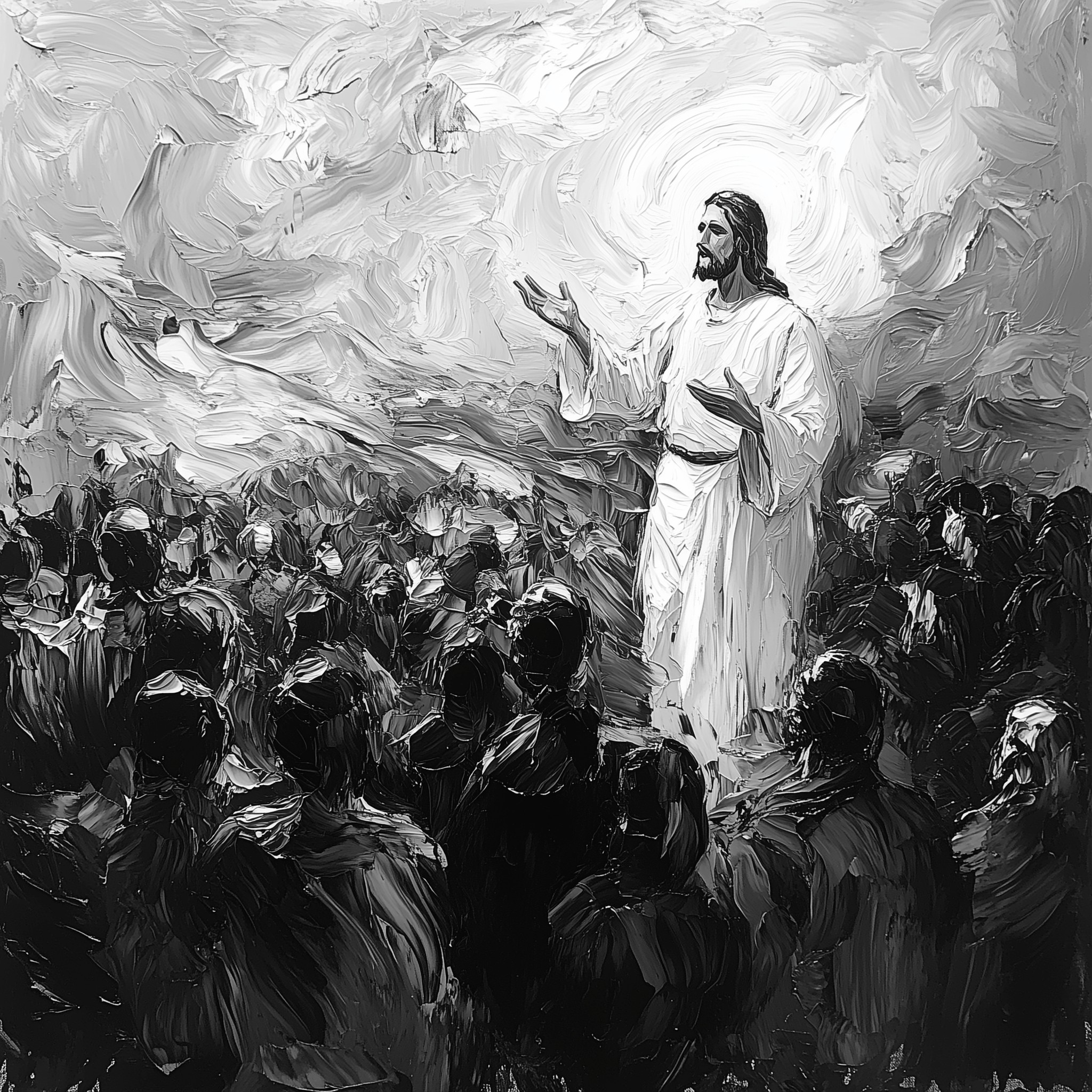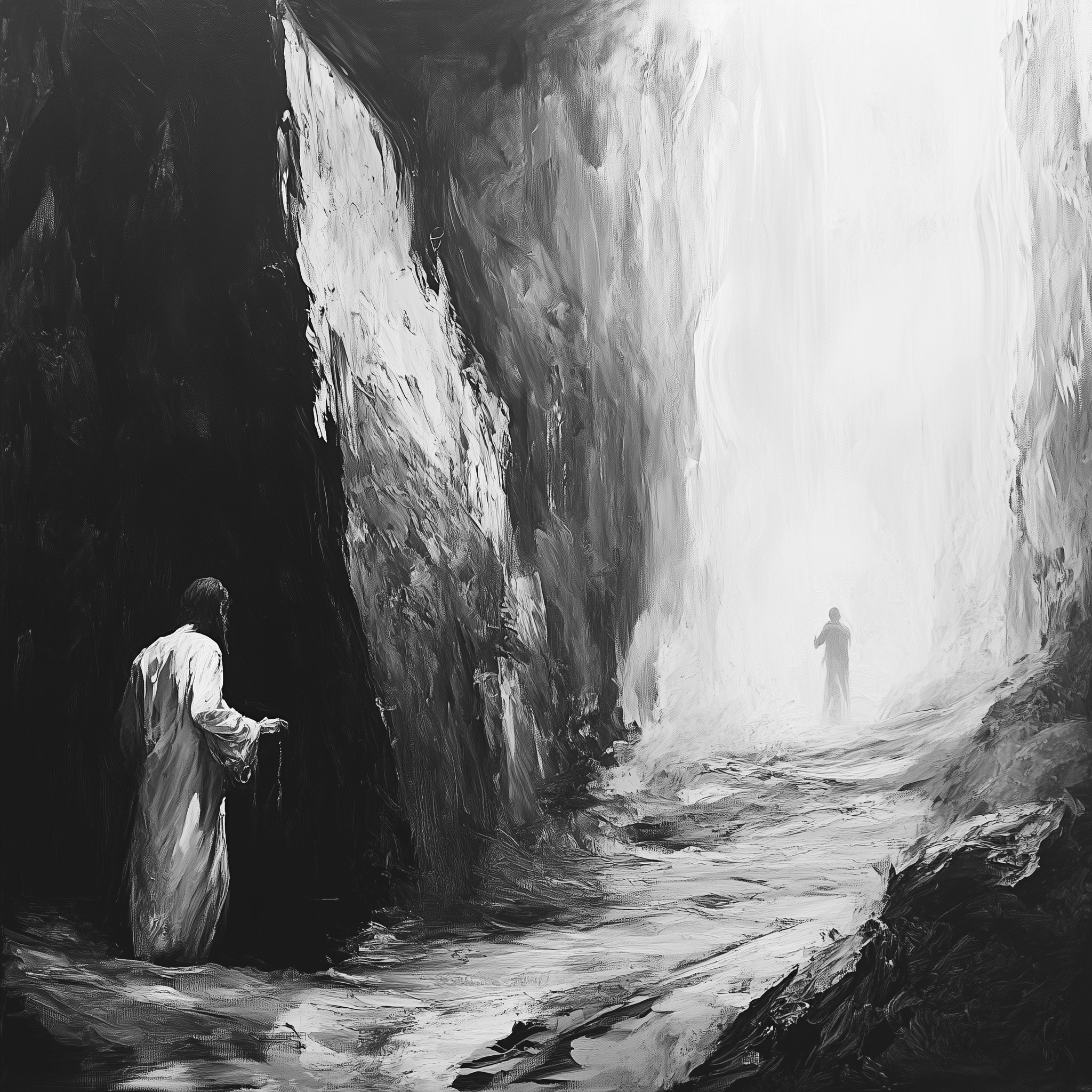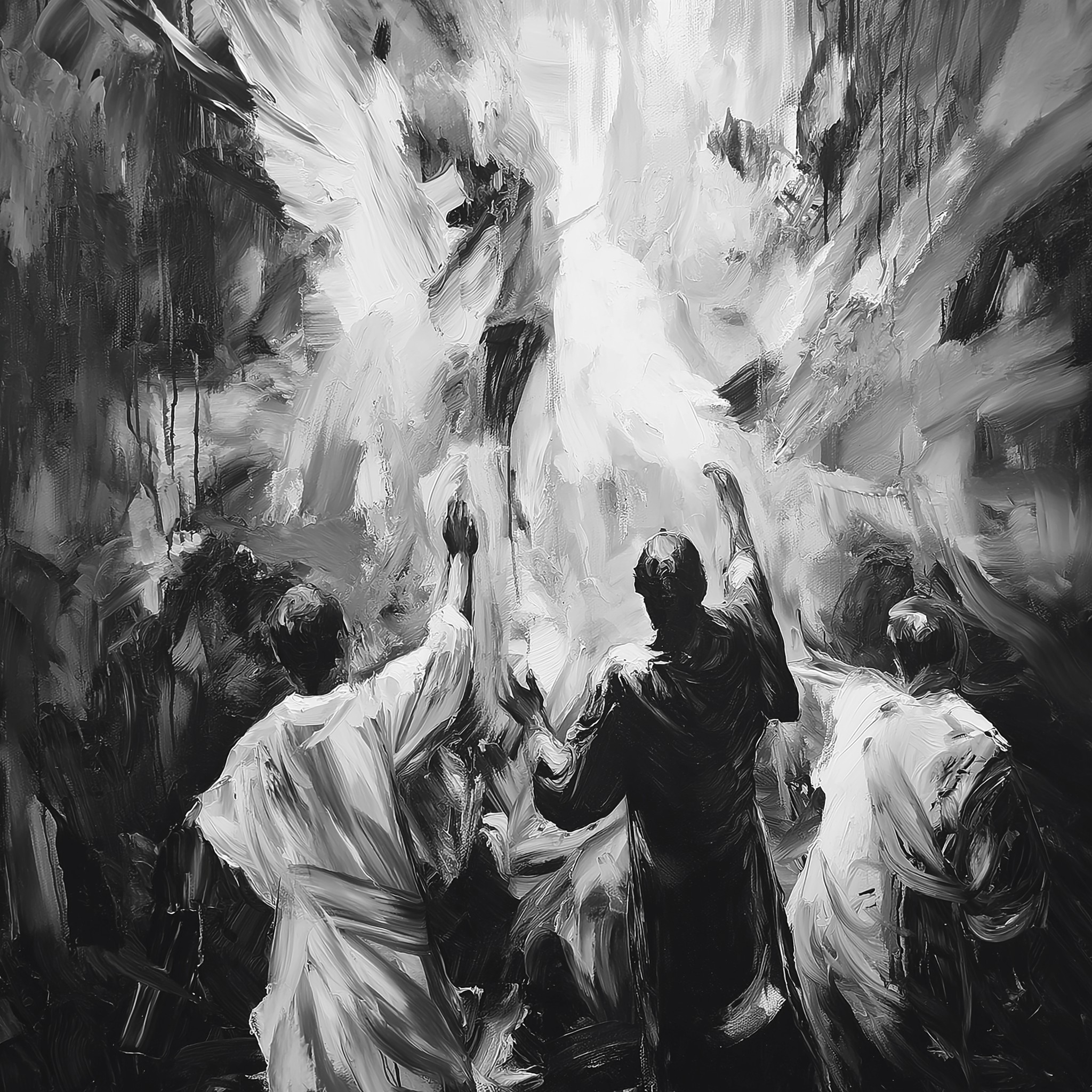Why could people see Jesus’s face? This intriguing question delves into the heart of Christian theology, exploring the divine and human nature of Jesus Christ and the concept of seeing God. At WHY.EDU.VN, we aim to provide clarity and understanding. We’ll explore theological perspectives, scriptural interpretations, and historical context to help you understand how the appearance of Jesus aligns with broader spiritual truths. Join us as we unpack this fascinating topic! Dive into scriptures, theological doctrines, and historical analysis to discover comprehensive answers and related exploration.
1. The Hypostatic Union: Bridging the Divine and Human
The ability of people to see Jesus’s face is intrinsically linked to the hypostatic union, a core doctrine in Christian theology. This doctrine explains how Jesus Christ is both fully God and fully human in one person. This unique union allowed individuals to perceive the divine through a human form, making God accessible in a way that would otherwise be impossible.
1.1. Defining the Hypostatic Union
The hypostatic union, derived from the Greek words “hypostasis” (person or substance) and “union” (coming together), asserts that in Jesus Christ, there exists one person with two distinct natures: divine and human. These natures are united without mixture, change, division, or separation, as articulated in the Chalcedonian Definition (451 AD).
1.2. Implications of Jesus’s Humanity
Jesus’s humanity was vital for several reasons:
- Mediation: As stated in 1 Timothy 2:5, Jesus serves as the mediator between God and humanity. His human nature allows Him to empathize with human struggles and represent humanity before God.
- Relatability: People could relate to Jesus because He experienced human emotions, challenges, and limitations. This relatability made His teachings and actions more impactful.
- Sacrifice: Jesus’s human body allowed Him to offer the ultimate sacrifice for the sins of humanity through His death on the cross.
1.3. Scriptural Basis for Jesus’s Humanity
The New Testament provides ample evidence of Jesus’s humanity. For instance, Philippians 2:5-8 describes Jesus emptying Himself and taking the form of a servant, being born in the likeness of men. Other examples include:
- Matthew 4:2: Jesus experienced hunger after fasting for forty days.
- John 11:35: Jesus wept at the death of His friend Lazarus.
- Luke 22:44: Jesus experienced anguish in the Garden of Gethsemane before His crucifixion.
These passages illustrate that Jesus lived a fully human life, experiencing the same emotions and physical needs as any other person.
1.4. Addressing Apparent Contradictions
The concept of seeing God’s face often raises questions due to passages in the Old Testament that suggest seeing God is fatal. Exodus 33:20 states, “you cannot see my face, for man shall not see me and live.” This verse highlights the incomprehensible holiness and glory of God, which would overwhelm any mortal. However, the incarnation of Jesus provides a resolution to this apparent contradiction.
1.5. Jesus as the Visible Image of the Invisible God
The New Testament presents Jesus as the visible image of the invisible God. Colossians 1:15 states, “He is the image of the invisible God, the firstborn of all creation.” This verse suggests that Jesus reveals God’s nature in a way that humans can comprehend.
Furthermore, John 1:18 asserts, “No one has ever seen God, but the one and only Son, who is himself God and is in closest relationship with the Father, has made him known.” Jesus, through His words, actions, and very presence, reveals the character and nature of God to humanity.
2. Exodus 33: Unveiling God’s Glory and Limitations
Exodus 33 is a pivotal passage in understanding the complexities of seeing God’s face. This chapter recounts an interaction between Moses and God, highlighting both the intimacy and the limitations of their relationship. It also provides key context for understanding why the incarnation of Jesus was necessary.
2.1. Context of the Passage
Exodus 33 occurs after the Israelites committed idolatry by worshiping the golden calf. Moses intercedes on their behalf, seeking God’s continued presence and guidance. The chapter describes Moses’s dialogue with God in the Tent of Meeting, a sacred space where they communicated.
2.2. Moses’s Bold Request
In verse 18, Moses makes a bold request: “Show me your glory.” This request goes beyond the regular “face to face” interactions he had with God. Moses desires a deeper, more profound revelation of God’s divine nature.
2.3. God’s Response: A Partial Revelation
God responds to Moses’s request in verses 19-20, stating, “I will cause all my goodness to pass in front of you, and I will proclaim my name, the Lord, before you. I will have mercy on whom I will have mercy, and I will have compassion on whom I will have compassion. But,” he said, “you cannot see my face, for no one may see me and live.”
This response indicates that God is willing to reveal His goodness and proclaim His name to Moses. However, He sets a limit, stating that Moses cannot see His face because it would be fatal.
2.4. Interpreting “Face to Face”
The passage seems contradictory because Exodus 33:11 states, “Thus the Lord used to speak to Moses face to face, as a man speaks to his friend.” This implies a close, personal relationship. However, the “face to face” interaction described in verse 11 is different from the full revelation of God’s glory that Moses requests in verse 18.
The “face to face” encounters likely refer to a mediated form of communication, where God’s presence is manifested in a way that Moses can comprehend and endure. It does not imply a direct, unshielded view of God’s full glory.
2.5. The Significance of God’s Goodness
Instead of showing Moses His full glory, God promises to show His goodness. This suggests that God’s character, His attributes of love, mercy, and compassion, are the most important aspects of His nature to reveal. As Rabbi Michelle Perlman notes, God is most fully seen and experienced through divine acts of goodness, grace, and compassion.
2.6. Protection in the Cleft of the Rock
To partially fulfill Moses’s request, God tells Moses to stand on a rock and hide in its cleft. As God’s glory passes by, He will cover Moses with His hand, allowing him to see only His back (Exodus 33:21-23). This imagery symbolizes God’s protection and the limitations of human perception.
The experience of Moses highlights that while humans can experience God’s presence and goodness, they cannot fully comprehend His divine glory in their mortal state. This understanding sets the stage for the incarnation of Jesus, who makes God accessible in a human form.
3. Biblical Examples: Encounters with the Divine
Several other biblical accounts describe encounters with divine beings, often resulting in fear and a sense of impending death. These stories reinforce the idea that seeing God or His messengers can be overwhelming and potentially fatal for humans.
3.1. Gideon’s Encounter (Judges 6:22-23)
In Judges 6, Gideon encounters an angel of the Lord and realizes he has seen God face to face. His immediate reaction is fear, as he believes he will die. “Alas, O Lord God! For now I have seen the angel of the Lord face to face.” However, God assures him, “Peace be to you. Do not fear; you shall not die.”
3.2. Manoah’s Experience (Judges 13:21-23)
Similarly, in Judges 13, Manoah and his wife have an encounter with the angel of the Lord. After the angel ascends in the flame of the altar, Manoah realizes he has seen God and expresses fear of death. “We shall surely die, for we have seen God.” His wife, however, reasons that if God intended to kill them, He would not have accepted their offerings or shown them such things.
3.3. Isaiah’s Vision (Isaiah 6:1-5)
One of the most powerful accounts is Isaiah’s vision in Isaiah 6. Isaiah sees the Lord sitting on a throne, high and lifted up, with the train of His robe filling the temple. Overwhelmed by the vision, Isaiah cries out, “Woe is me! For I am lost; for I am a man of unclean lips, and I dwell in the midst of a people of unclean lips; for my eyes have seen the King, the Lord of hosts!”
3.4. Common Themes
These examples share several common themes:
- Fear and Awe: The individuals are filled with fear and awe upon realizing they have encountered the divine.
- Recognition of Unworthiness: They recognize their own unworthiness and sinfulness in the presence of God.
- Assurance of Protection: God or His messenger assures them that they will not die, often accompanied by a specific mission or purpose.
3.5. Interpretation
These accounts suggest that encountering God’s presence is a transformative experience that requires divine grace and protection. The fear of death reflects an understanding of the vast difference between human limitations and divine power. These encounters set the stage for understanding the unique role of Jesus Christ in making God accessible to humanity.
4. Jesus: God’s Face Revealed
The incarnation of Jesus Christ represents a unique and transformative moment in the relationship between God and humanity. Through Jesus, God’s face is revealed in a way that is both accessible and life-giving.
4.1. Jesus as the Fullness of God (Colossians 2:9)
Colossians 2:9 states, “For in him the whole fullness of deity dwells bodily.” This verse emphasizes that Jesus is not merely a representation of God but the very embodiment of God in human form. Through Jesus, the divine nature is fully present in a way that humans can comprehend and relate to.
4.2. Seeing Jesus, Seeing the Father (John 14:9)
In John 14:9, Jesus tells Philip, “Anyone who has seen me has seen the Father.” This statement highlights the inseparable connection between Jesus and God. Jesus is the perfect representation of God’s character, attributes, and will. By seeing Jesus, people are, in essence, seeing God.
4.3. Jesus’s Teachings and Actions
Jesus’s teachings and actions further reveal God’s nature. His parables, miracles, and interactions with people demonstrate God’s love, mercy, and compassion. For example, the parable of the Good Samaritan (Luke 10:25-37) illustrates God’s concern for all people, regardless of their background or status. His miracles, such as healing the sick and raising the dead, demonstrate God’s power and compassion.
4.4. Transforming Encounters
Encounters with Jesus were transformative for those who believed in Him. His disciples left their former lives to follow Him, and many others were healed, forgiven, and given new hope. These encounters demonstrate the life-changing power of seeing God’s face in Jesus.
4.5. The Transfiguration (Matthew 17:1-9)
The Transfiguration provides a glimpse of Jesus’s divine glory. In this event, Jesus takes Peter, James, and John to a high mountain, where He is transfigured before them. His face shines like the sun, and His clothes become dazzling white. Moses and Elijah appear and speak with Him. This event confirms Jesus’s divine nature and foreshadows the glory that awaits believers in the kingdom of God.
4.6. The Significance of Jesus’s Resurrection
The resurrection of Jesus is the ultimate demonstration of God’s power and love. It confirms that Jesus is the Son of God and that He has conquered sin and death. The resurrected Jesus appears to His disciples, offering them proof of His victory and commissioning them to spread the gospel.
5. Seeking God’s Face Today
While we may not have the opportunity to see Jesus in the flesh, we can still seek God’s face today through various means. The Bible encourages believers to continually seek God’s presence and to grow in their relationship with Him.
5.1. Prayer and Meditation
Prayer and meditation are essential practices for seeking God’s face. Through prayer, we can communicate with God, express our needs and desires, and seek His guidance. Meditation allows us to focus our minds on God’s Word and to reflect on His character and attributes.
5.2. Studying the Scriptures
Studying the Scriptures is another way to see God’s face. The Bible reveals God’s character, His plan for humanity, and His promises to those who believe in Him. By studying the Scriptures, we can gain a deeper understanding of God and His will for our lives.
5.3. Fellowship with Other Believers
Fellowship with other believers is also important. When we gather together to worship, study, and serve, we experience God’s presence in a unique way. Fellowship provides support, encouragement, and accountability as we seek to grow in our faith.
5.4. Serving Others
Serving others is a practical way to see God’s face. When we minister to the needs of others, we are reflecting God’s love and compassion. Jesus said, “Truly I tell you, whatever you did for one of the least of these brothers and sisters of mine, you did for me” (Matthew 25:40).
5.5. Living a Life of Obedience
Living a life of obedience to God’s commands is essential for seeing His face. When we strive to live according to God’s will, we are opening ourselves to His blessings and His presence. Obedience demonstrates our love for God and our desire to please Him.
5.6. Experiencing God’s Goodness
As we seek God’s face, we will experience His goodness in various ways. We may see His hand at work in our lives, experience His peace in the midst of trials, or sense His presence in moments of worship. These experiences confirm that God is with us and that He is actively involved in our lives.
5.7. The Promise of Seeing God’s Face in Eternity
Revelation 22:3-4 offers a comforting promise: “No longer will there be any curse. The throne of God and of the Lamb will be in the city, and his servants will serve him. They will see his face, and his name will be on their foreheads.” This passage suggests that in eternity, believers will have the privilege of seeing God’s face in all its glory, without any limitations or fear.
6. Theological Perspectives on Seeing God
Different theological traditions offer diverse perspectives on the concept of seeing God. Understanding these perspectives can enrich our understanding of this complex topic.
6.1. Eastern Orthodox Theology
In Eastern Orthodox theology, the concept of theosis (divinization or becoming like God) is central. Theosis involves a progressive transformation whereby believers participate in the divine nature through grace. Seeing God is not merely a physical act but a spiritual transformation that allows believers to perceive God’s glory.
6.2. Catholic Theology
Catholic theology emphasizes the beatific vision, which refers to the direct and immediate vision of God in heaven. This vision is the ultimate goal of human existence and is reserved for those who die in a state of grace. The beatific vision is described as a state of perfect happiness and fulfillment.
6.3. Protestant Theology
Protestant theology emphasizes the importance of faith in Jesus Christ for salvation. Seeing God is understood as a spiritual experience that occurs through faith and the indwelling of the Holy Spirit. Protestants also look forward to the future vision of God in heaven.
6.4. Mystical Traditions
Mystical traditions within Christianity, such as those found in the writings of mystics like Teresa of Avila and John of the Cross, emphasize the importance of direct, personal experience of God. These mystics describe encounters with God that transcend ordinary sensory perception and involve a deep sense of union with the divine.
7. The Role of Art and Imagery
Art and imagery have played a significant role in shaping perceptions of Jesus’s face throughout history. From early Christian art to Renaissance masterpieces, artists have sought to capture the essence of Jesus’s humanity and divinity.
7.1. Early Christian Art
Early Christian art often depicted Jesus as the Good Shepherd, a symbol of protection and care. These images emphasized Jesus’s compassion and His role as a guide for believers.
7.2. Byzantine Art
Byzantine art developed a distinctive style characterized by stylized figures, rich colors, and symbolic imagery. Icons of Jesus, such as the Pantocrator (Christ Almighty), portrayed Him as the ruler of the universe, emphasizing His divine authority.
7.3. Renaissance Art
Renaissance artists sought to create more realistic and humanistic depictions of Jesus. Artists like Leonardo da Vinci, Michelangelo, and Raphael produced masterpieces that captured the beauty, grace, and humanity of Jesus.
7.4. Modern and Contemporary Art
Modern and contemporary artists have continued to explore the image of Jesus in diverse and innovative ways. Some artists focus on Jesus’s suffering and sacrifice, while others emphasize His message of love and justice.
7.5. The Power of Images
Images of Jesus can be powerful tools for inspiring faith, devotion, and reflection. However, it is important to remember that these images are representations and not perfect reflections of the historical Jesus. The true essence of Jesus is found in His teachings, His actions, and His relationship with God.
8. Practical Steps to Deepen Your Spiritual Understanding
Deepening your understanding of seeing God’s face involves a combination of theological study, personal reflection, and practical application. Here are some steps you can take:
8.1. Study the Scriptures Regularly
Make it a habit to read and study the Bible regularly. Focus on passages that describe encounters with God and the character of Jesus. Use study tools such as commentaries, dictionaries, and concordances to gain a deeper understanding of the text.
8.2. Engage in Prayer and Meditation
Set aside time each day for prayer and meditation. Use prayer to communicate with God, express your gratitude, and seek His guidance. Use meditation to focus your mind on God’s Word and to reflect on His presence in your life.
8.3. Seek Mentorship and Guidance
Find a mentor or spiritual advisor who can provide guidance and support as you seek to grow in your faith. Look for someone who is knowledgeable, compassionate, and committed to helping you deepen your understanding of God.
8.4. Participate in a Community of Faith
Join a church or other faith community where you can worship, study, and serve alongside other believers. Participate in small groups, Bible studies, and service projects to connect with others and grow in your faith.
8.5. Serve Others in Need
Look for opportunities to serve others in your community. Volunteer at a local charity, help those who are struggling, or offer your time and talents to those in need. Serving others is a practical way to demonstrate God’s love and to deepen your own faith.
8.6. Reflect on Your Experiences
Take time to reflect on your experiences and to consider how God is working in your life. Keep a journal to record your thoughts, feelings, and insights. Pay attention to the ways in which God is revealing Himself to you.
8.7. Embrace Humility and Openness
Approach the topic of seeing God’s face with humility and openness. Recognize that your understanding is limited and that there is always more to learn. Be willing to consider different perspectives and to challenge your own assumptions.
9. Addressing Common Misconceptions
Several misconceptions surround the topic of seeing God’s face. Addressing these misconceptions can help clarify understanding and promote accurate interpretation.
9.1. Misconception: Seeing God is a Literal, Physical Act
Some people believe that seeing God is a literal, physical act. However, the Bible suggests that seeing God is more than just a physical experience. It involves a spiritual transformation that allows believers to perceive God’s glory and to understand His character.
9.2. Misconception: Seeing God is Only for a Select Few
Another misconception is that seeing God is only for a select few, such as prophets or mystics. While some individuals may have unique encounters with God, the Bible encourages all believers to seek His face and to grow in their relationship with Him.
9.3. Misconception: Seeing God Guarantees Instant Perfection
Some people believe that seeing God guarantees instant perfection. However, the Bible suggests that spiritual growth is a gradual process that involves ongoing effort and commitment. Seeing God can be a transformative experience, but it does not automatically eliminate all flaws and weaknesses.
9.4. Misconception: All Visions of God Are Authentic
Not all visions of God are authentic. The Bible warns against false prophets and deceptive spirits. It is important to test all spiritual experiences against the teachings of Scripture and to seek guidance from trusted spiritual leaders.
9.5. Misconception: God Can Be Fully Captured in Human Art
Human art can inspire and encourage spiritual reflection, but it cannot fully capture the essence of God. God transcends human understanding and cannot be perfectly represented in any form.
10. Why Choose WHY.EDU.VN for Your Spiritual Queries?
At WHY.EDU.VN, we are dedicated to providing accurate, insightful, and accessible information on a wide range of topics, including complex theological questions. We understand the challenges of finding reliable answers in a world filled with misinformation, and we are committed to being a trusted resource for seekers of truth.
10.1. Expertly Curated Content
Our content is carefully curated by experts in various fields, ensuring that you receive the most accurate and up-to-date information available. We consult with theologians, scholars, and researchers to provide comprehensive and nuanced explanations.
10.2. Clear and Accessible Explanations
We understand that complex topics can be difficult to grasp. That’s why we strive to present information in a clear, concise, and accessible manner. We avoid jargon and technical terms whenever possible and provide definitions and explanations for those that are necessary.
10.3. Diverse Perspectives
We recognize that different perspectives can enrich understanding. We strive to present a variety of viewpoints and interpretations, allowing you to form your own informed opinions. We also acknowledge the limitations of human knowledge and encourage critical thinking.
10.4. Commitment to Accuracy
Accuracy is our top priority. We rigorously fact-check our content and provide citations to reputable sources. We are committed to correcting any errors promptly and transparently.
10.5. User-Friendly Platform
Our website is designed to be user-friendly and easy to navigate. You can quickly find the information you need and explore related topics. We also offer a variety of features to enhance your learning experience, such as interactive quizzes, discussion forums, and personalized recommendations.
10.6. Community Support
We foster a supportive and respectful community where you can connect with other seekers of truth. You can ask questions, share insights, and engage in meaningful discussions. Our team of moderators is dedicated to creating a safe and welcoming environment for all users.
10.7. Continual Improvement
We are committed to continually improving our content and services. We welcome feedback from our users and use it to make our platform even more valuable. We stay up-to-date with the latest research and developments and incorporate them into our content.
Understanding why people could see Jesus’s face requires delving into theological depths, examining scriptural contexts, and appreciating historical nuances. This exploration reveals the profound mystery of the hypostatic union and the transformative power of encountering the divine.
Have more questions about theology, spirituality, or any other topic? Visit WHY.EDU.VN today and connect with our experts. We are here to provide you with clear, accurate, and insightful answers to your most pressing questions. Reach out to us at 101 Curiosity Lane, Answer Town, CA 90210, United States. Whatsapp: +1 (213) 555-0101. Website: WHY.EDU.VN. We look forward to helping you on your journey of discovery.
FAQ: Why Could People See Jesus’s Face?
Here are some frequently asked questions regarding the topic of why people could see Jesus’s face, aiming to clarify common points of confusion and offer deeper insights:
| Question | Answer |
|---|---|
| 1. What is the hypostatic union? | The hypostatic union is a theological doctrine asserting that Jesus Christ is both fully God and fully human in one person. These two natures are united without mixture, change, division, or separation. |
| 2. Why was Jesus’s humanity important? | Jesus’s humanity was vital for several reasons: He served as a mediator between God and humanity, allowing Him to empathize with human struggles; people could relate to Him because He experienced human emotions; and His human body allowed Him to offer the ultimate sacrifice for the sins of humanity. |
| 3. What does the Bible say about seeing God’s face? | Exodus 33:20 states that no one can see God’s face and live, highlighting the incomprehensible holiness and glory of God. However, the New Testament presents Jesus as the visible image of the invisible God, allowing humans to comprehend God’s nature. |
| 4. How did Moses speak to God face to face? | The “face to face” interactions between Moses and God likely refer to a mediated form of communication where God’s presence was manifested in a way that Moses could comprehend and endure. It does not imply a direct, unshielded view of God’s full glory. |
| 5. What does it mean to seek God’s face today? | Seeking God’s face today involves practices such as prayer, meditation, studying the Scriptures, fellowship with other believers, serving others, and living a life of obedience to God’s commands. It is a continual process of growing in relationship with God and experiencing His presence in our lives. |
| 6. What is the significance of the Transfiguration? | The Transfiguration provided a glimpse of Jesus’s divine glory. In this event, Jesus’s face shone like the sun, and His clothes became dazzling white. Moses and Elijah appeared and spoke with Him, confirming Jesus’s divine nature and foreshadowing the glory that awaits believers in the kingdom of God. |
| 7. How do different theologies view seeing God? | Eastern Orthodox theology emphasizes theosis, the process of becoming like God; Catholic theology focuses on the beatific vision, the direct vision of God in heaven; and Protestant theology highlights the importance of faith in Jesus Christ for salvation and the future vision of God in heaven. |
| 8. What role does art play in understanding Jesus? | Art and imagery have played a significant role in shaping perceptions of Jesus’s face throughout history. From early Christian art to Renaissance masterpieces, artists have sought to capture the essence of Jesus’s humanity and divinity. These images can inspire faith, devotion, and reflection. |
| 9. How can I deepen my spiritual understanding? | Deepening your spiritual understanding involves studying the Scriptures regularly, engaging in prayer and meditation, seeking mentorship and guidance, participating in a community of faith, serving others in need, reflecting on your experiences, and embracing humility and openness. |
| 10. Where can I find reliable answers to my questions? | At why.edu.vn, we provide accurate, insightful, and accessible information on a wide range of topics, including complex theological questions. Our content is curated by experts, presented in a clear manner, and committed to accuracy. We offer a user-friendly platform and a supportive community for seekers of truth. Contact us at 101 Curiosity Lane, Answer Town, CA 90210, United States. Whatsapp: +1 (213) 555-0101. |




